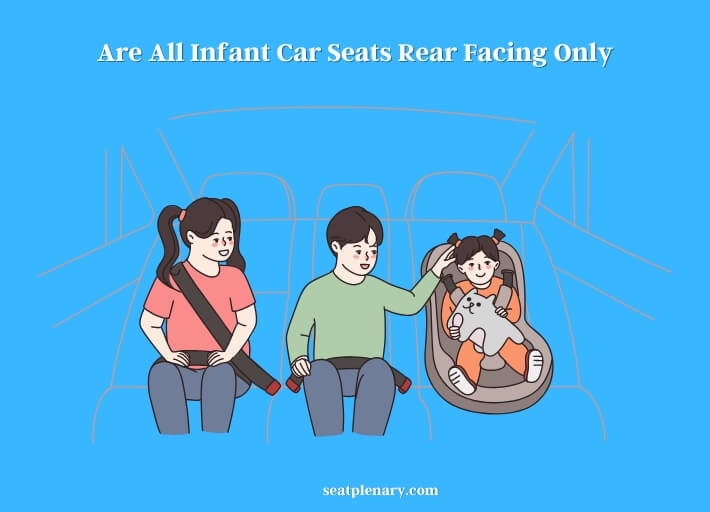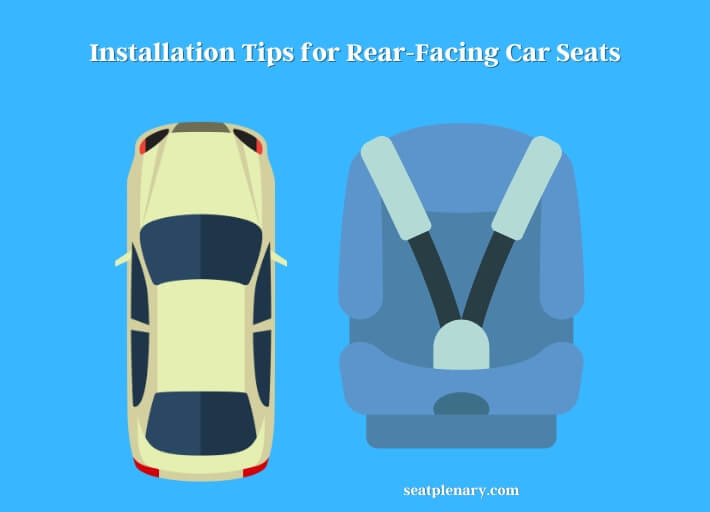When it comes to the safety of your child, there’s no room for compromise. One crucial component of this safety is the infant car seat. However, a common question that boggles the mind of many parents is: “are all infant car seats rear facing only?” It’s a seemingly simple question, but the answer opens up a universe of knowledge about car seat safety. Let’s buckle up and dive in.

Are all infant car seats rear facing only?
Yes, all infant car seats are designed to be rear facing only. Rear-facing car seats are proven to be the safest option for infants, especially for their head, neck, and spinal cord. This arrangement offers the best protection in the event of a sudden stop or crash. The American Academy of Pediatrics (AAP) recommends keeping your child in a rear-facing car seat for as long as possible.
Why are infant car seats rear facing?
Infant car seats are rear facing due to their specific design which provides superior protection for infants during collisions. Babies have weak neck muscles and heavy heads. If placed forward-facing, the force of even a low-speed collision could cause severe spinal cord injuries.
The Anatomy of a Rear-Facing Infant Car Seat
When looking at a rear-facing car seat, several features make it perfect for newborns and young toddlers. These include:
- A deep, reclining shell that offers side-impact protection.
- Harness slots positioned at or below the child’s shoulders.
- An infant insert or low bottom harness position for newborn fit.
- A 5-point harness that goes over both shoulders and hips, connecting at the crotch.
When to Switch From Rear-Facing to Forward-Facing
Switching from a rear-facing to a forward-facing position isn’t about age, but rather size and weight. Once your child surpasses the manufacturer’s height and weight limits for the rear-facing car seat, it’s time to make the switch. You can watch the 30 second video below:
The Debate: Rear Facing Vs. Forward Facing
This is a topic that’s sparked much debate among parents and safety experts alike. Let’s examine the pros and cons.
Benefits of Rear-Facing Car Seats
Rear-facing car seats have several advantages. They offer better protection for your child’s head, neck, and spine in a collision. Also, they reduce the risk of injury in side-impact crashes as the entire back of the car seat cradles the child. Still confused? Then the following video can help you:
Downsides of Rear-Facing Car Seats
The most common downside of rear-facing car seats is that they take up more space, making them impractical for small cars. Also, it’s challenging to see your baby while driving, which can be unsettling for some parents.
Benefits of Forward-Facing Car Seats
A forward-facing car seat offers more legroom for your child and a better view for the parent. Some models also come with additional safety features like impact shields.
Downsides of Forward-Facing Car Seats
The major downside to forward-facing car seats is the increased risk of injury in a collision. The forward force can cause a child’s head to jerk forward, potentially leading to spinal cord injuries.
Choosing the Right Car Seat
Choosing the right car seat can be an uphill battle, considering the variety of options available. Understanding the basics can make the decision-making process smoother.
Understanding the Types of Car Seats
Broadly, car seats are divided into three categories: infant car seats, convertible car seats, and booster seats. While infant car seats are exclusively rear-facing, convertible car seats can be both rear and forward-facing. Booster seats, on the other hand, are designed for older children and are always forward-facing.
Key Factors to Consider
When choosing a car seat, consider the following factors:
- Safety standards: Ensure the car seat meets the safety standards outlined by the National Highway Traffic Safety Administration (NHTSA).
- Size and fit: Check if the car seat fits your vehicle and your child properly.
- Ease of installation and use: An easy-to-install and user-friendly car seat can make your life much easier.
- Comfort: Features like cushioning, a reclining seat, and adjustable harness can contribute to your child’s comfort.
Convertible Car Seats: A Long-Term Solution
[amazon fields=”B09YTN79H7″ value=”thumb” image_size=”large” image_align=”center” image_alt=””]
[amazon link=”B09YTN79H7″ title=”Convertible car seats” /] could be an economical and long-lasting solution for many parents. These car seats are designed to grow with your child, starting from infancy to toddlerhood, transitioning from rear-facing to forward-facing as your child grows.
Installation Tips for Rear-Facing Car Seats
Installing a rear-facing car seat might seem tricky, but with the right guidance, it’s a piece of cake. Here are some key tips:

- Always follow the car seat manufacturer’s instructions.
- The car seat should be at the right angle – check the user manual for specifics.
- The harness straps should be at or below the baby’s shoulders.
- The harness should be snug so that you cannot pinch a fold in the strap.
The following video will help you to install it properly:
Common Mistakes to Avoid
Even the most well-intentioned parents can make mistakes when it comes to car seats. Avoid these common pitfalls:
- Moving to a forward-facing car seat too soon.
- Incorrectly installing the car seat.
- Not securing the child properly.
- Using a car seat that’s expired or has been in a crash.
FAQs
Are all infant car seats rear facing only?
Yes, all infant car seats are rear facing only. They are designed this way to offer maximum protection to the infant’s head, neck, and spine during collisions.
How long should a child be in a rear-facing car seat?
The American Academy of Pediatrics (AAP) recommends that children should remain in a rear-facing car seat until they reach the highest weight or height allowed by the car seat manufacturer, which is typically around two years of age.
Can Infant Car Seats Convert to Jump Seats for Older Children?
Yes, some infant car seats can convert to jump seats for older children. Jump seat basics should be considered before making the switch. Ensure proper installation and use according to the manufacturer’s guidelines. It’s important to check weight and size restrictions to ensure safety for older children.
Can I put a rear-facing car seat in the front seat of the car?
No, it’s not safe to place a rear-facing car seat in the front seat of a car, especially if there’s an active passenger airbag. In the event of a collision, the airbag could hit the back of the car seat, resulting in severe injury or death.
What should I do if my child’s feet touch the back of the car seat in the rear-facing position?
It’s perfectly normal for a child’s legs or feet to touch the back of the car seat in the rear-facing position. This does not necessarily mean they’re ready to switch to a forward-facing car seat.
Are rear-facing car seats safer than forward-facing ones?
Yes, rear-facing car seats are considered safer than forward-facing ones for children under the age of two. They offer better support for the child’s head, neck, and spine.
What is the best rear-facing car seat?
The ‘best’ car seat depends on various factors, including your child’s age, weight, height, and the size of your vehicle. Always look for a car seat that fits your child and can be properly installed in your car.
Conclusion
“Are all infant car seats rear facing only?”—this question is just the tip of the iceberg when it comes to ensuring your child’s safety during travel. While the answer is yes, understanding why, and the specifics of car seat safety, is crucial for every parent. When correctly chosen and properly installed, rear-facing infant car seats offer the best protection for our most precious cargo, our children.
So, when you hit the road, remember the importance of rear-facing car seats, and ensure you’re using the seat correctly. After all, nothing is more important than your child’s safety.
You May Like These Resources:
